Exporting Outlook tasks to Excel, CSV and .msg formats
An ideal way to back up your Outlook task is to synchronize between your cloud task such as Google and your Outlook with some sync Outlook add-in like EVO Collaborator for Outlook. However, when such synchronization is not available, you can still manually export your Outlook task to your external hard drive by some mean. Besides EVO’s Power Toys for Outlook (Click to download for trial),

Outlook generally provides 3 formats that tasks can be exported into with some downfall which we will talk about later in this article. Let’s first brief what these 4 formats are:
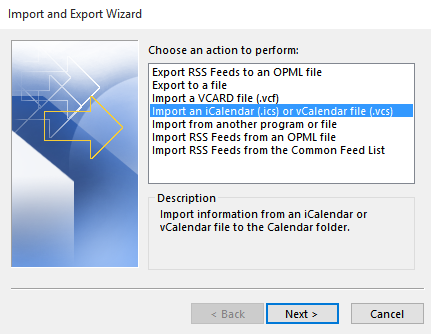
Outlook Message Format – Unicode:
Advertisement
- Outlook saves tasks into a file format of Outlook Message Format. One thing good about this file is that this file format retains all properties and metadata fully compatible with Outlook.
- Other than Outlook Message Format -Unicode, theoretically, Outlook tasks can also be saved as .ICS file format with aide from CalDAV protocol. Some Outlook add-in is able to convert Outlook tasks into .ICS and interact with other CalDAV task services on the market.
- Export:
- Each of these Outlook Message Format files counts toward one task and it can be imported back to Outlook. The downfall of saving events into .ics or .vcs files is that you can only save one event at a time. Up to some point, it is not practical when trying to import a large number of tasks at once. If you try to select all your tasks and save them, you would end up with one single TXT file instead. This TXT file cannot be used for import and it is probably good for printout.
- You can follow the steps below to save your task as Outlook Message Format – Unicode file: (We use Outlook 2016 in tutorials throughout this article)
- Click on Tasks at lower-left.

- Click on selected task entry in the selected task folder under Navigation Pane of My Tasks.
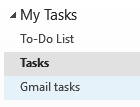
- Click on File at top-left.
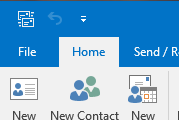
- Select Save As.
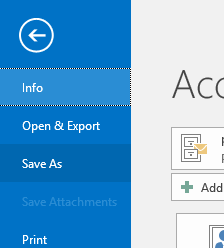
- Browse to location where you will be saving the msg file.

- Click on Save button.
- Click on Tasks at lower-left.
- If you have e-mail access, then there is another way to compliment the above one-by-one vCard saving solution:
- Click on Tasks at lower-left.

- Select the task folder you want to export under Navigation Pane of My Tasks.

- Use hotkey of CTRL + A to select all tasks and CTRL + C to copy all of them.

- Click on Mail at lower-left.

- Click on New Email at top-left.
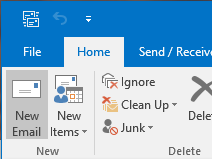
- Fill in e-mail address you want to send your tasks backup to.
- Click on body section of the newly created e-mail.
- Use hotkey of CTRL + V to paste all the tasks you just copied to clipboard.

- Click on Send button to send tasks to your e-mail address.
- Click on Tasks at lower-left.
- Import:
- There are two methods to import your msg files of Tasks back to Outlook. One is through Drag & Drop:
- Open Windows Explorer.
- Browse to the folder where msg files of Tasks are located.

- Select all that you like to import by hot key of CTRL+A for selecting all msg files or CTRL+Mouse Click for multi-select.
- Drag all selected files and drop them in the folder of your choice under My Tasks in Outlook’s Navi Panel.

- Another method is is through open and save:
- Open Windows Explorer.
- Browse to the folder where msg files of Tasks are located.

- Select one msg file of Tasks and double-click the file to open it.
- Click on File at top-left.

- Click on Move to Folder button and select Copy to folder….

- Select the folder where you like to move the task to.

- Click on OK.
- Note: .msg files cannot also be imported into Thunderbird due to file incompatibility.
- There are two methods to import your msg files of Tasks back to Outlook. One is through Drag & Drop:
CSV: Export Outlook tasks to CSV
- Export:
- CSV (Common Separated Values) file is commonly used to store data for import and export in various software applications. Outlook uses CSV to store its task entry information since common (,) can be conveniently used to separate all fields. However, exporting Outlook tasks into a CSV file has a potential character encoding issue that characters other than ASCII and the language version your Outlook was installed contained in the task entries will be corrupted. For example, if you install the Korean version of Outlook and your task entries contain any Japanese hiragana or katakana,which are not in UTF-8 or Unicode, then these Japanese characters will appear as junky characters or question marks in the exported vCard files even though they look OK in Outlook before exporting.

- One good thing about using CSV is that you export the whole task folder or sub-folder as a whole. The following steps will walk you through on how to do it:
- Click on File at top-left.

- Click on Open & Export.
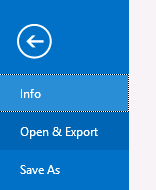
- Select Import/Export.
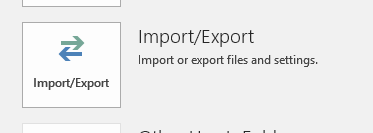
- Select Export to a file and click on Next >.

- Keep Common Separated Values selected and click on Next >.
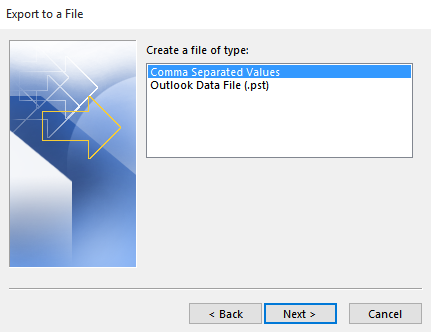
- Select task folder you want to export and click on Next >.

- Click on Browse button to browse a location for saving file.
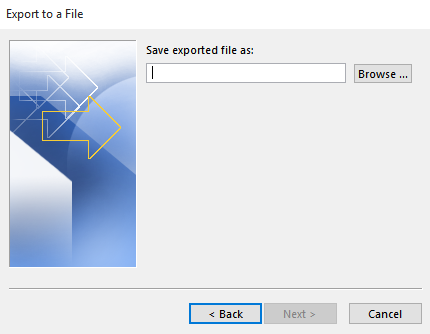
- Enter file name and then click on OK and Next >.
- Click on Finish.

- Enter date range of date during which appointments will be exported and click on OK. (Note that only part of recurring appointments falling into the date range will be exported.)
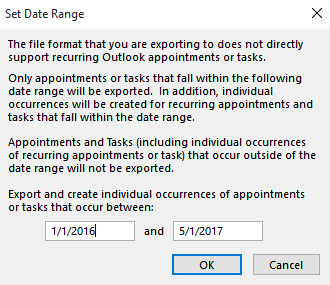
- As an export result, non-ASCII or non-Unicode foreign characters will end up series of question marks that we mentioned earlier in this section.
- Click on File at top-left.
- CSV (Common Separated Values) file is commonly used to store data for import and export in various software applications. Outlook uses CSV to store its task entry information since common (,) can be conveniently used to separate all fields. However, exporting Outlook tasks into a CSV file has a potential character encoding issue that characters other than ASCII and the language version your Outlook was installed contained in the task entries will be corrupted. For example, if you install the Korean version of Outlook and your task entries contain any Japanese hiragana or katakana,which are not in UTF-8 or Unicode, then these Japanese characters will appear as junky characters or question marks in the exported vCard files even though they look OK in Outlook before exporting.
- Import:
- Outlook provides an import wizard to facilitate bringing task entries stored in CSV files:
- Click on FILE at top-left.

- Click on Open & Export.

- Select Import/Export.

- Select Import from another program or file.
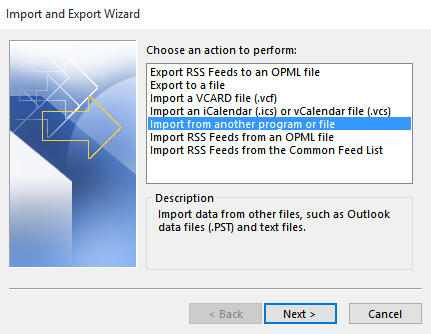
- Keep Common Separated Values selected and click on Next >.
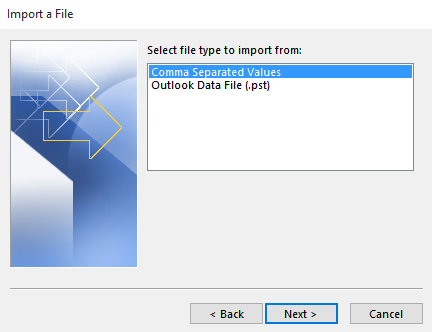
- Click on Browse to the folder location where you keep the CSV file.

- Click on one of radials under Options.
- Select a task folder as your destination in the folder tree and hit Next >.

- Make sure item in action list is checked and click on Finish.

- Click on FILE at top-left.
- As an import result, non-ASCII or non-Unicode foreign characters will end up series of question marks that we mentioned earlier in this section.

- CSV file exported from Outlook cannot be imported to Thunderbird perhaps due to incompatibility of field positioning.
- Outlook provides an import wizard to facilitate bringing task entries stored in CSV files:
Excel Spreadsheet: Export Outlook tasks to Excel 2016/2013
- Export:
- Outlook tasks are usually displayed in Simple-List view. If we like to simply copy & paste Outlook task entries to Excel spreadsheet, then it is better we change view to Detailed view. Moreover, by looking at the Detailed view, some of the fields we use within task entries may not be seen. Therefore, we need to make them visible before exporting. How? We add items via Add Columns.
- Copy & pasted task entries with foreign language characters are looking OK within Excel because Excel supports multi-languages. However, exporting the CSV file will result the same character encoding issue like exporting as CSV producing junky characters above.
- The following steps will export Outlook tasks via Copy & Paste method:
- Click on Tasks at lower-left.

- Select the task folder you want to export under Navigation Pane of My Tasks.

export outlook tasks to excel - Click on VIEW ribbon at top.

- Select Change View to the left.
- Click on Detailed and tasks events will appear in a listing fashion.
- If additional fields need to be included, click on Add Columns.

- Select field such as Owner to the left and click on Add -> button. Then, Owner will appear in the list to the right. If you need to re-arrange order of fields, then select fields and click on Move Up or Move Down to change position. When you finish, click OK to leave the Window.

- Use hot key of CTRL + A to select all tasks entries and use CTRL + C to copy them onto clipboard.

- Switch to Excel where you open a new workbook. Use CTRL + V to paste all copied entries.

- Click on Tasks at lower-left.
- Import:
- How do we import the saved Excel file back to Outlook since XLSX file extension is not an option in import source list? This is easy! What we do is save the workbook into a CSV file and follow the CSV import steps above. To save workbook files as CSV files, follow the steps below:
- In Excel application, open the Excel file and click on FILE at top-left.
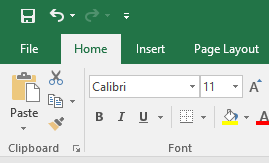
- Select Save As to the left.

- Click on Browse icon to browse the folder location where you want to save the CSV file.

- Pick a name for the CSV file.

- Click on Save as type pull-down list and select CSV (MS-DOS) or CSV (Comma Delimited).
- In Excel application, open the Excel file and click on FILE at top-left.
- As an import result, non-ASCII or non-Unicode foreign characters will end up series of question marks that we mentioned earlier in this section.

- How do we import the saved Excel file back to Outlook since XLSX file extension is not an option in import source list? This is easy! What we do is save the workbook into a CSV file and follow the CSV import steps above. To save workbook files as CSV files, follow the steps below:

